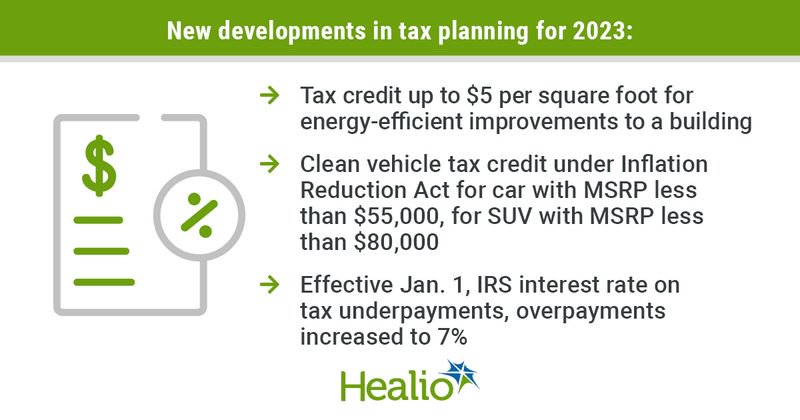What is new in 2023 for tax and asset protection planning
Click Here to Manage Email Alerts
As we are in early 2023, we plan to use this column to provide a high-level update on new developments in tax and asset protection planning, and hope these updates prompt some physicians to look into these areas early in the year.
Energy credits, higher interest charges
The Inflation Reduction Act of 2022 had some impact on tax planning, but not a lot that would impact orthopedists or their practices. One area that might be of relevance is the expanded tax credit for energy-efficient improvements. If a physician made any energy-efficient home improvements in 2022 or has plans to make those improvements in the future, there is a credit that now goes through 2032 and the credit amount has increased beginning in 2023 to 30% of the cost of the improvement, up to a maximum of $1,200 per year. The 2022 improvements are eligible for a $500 lifetime credit. For business or practice owners, there is also a credit for energy-efficient improvements up to $5 per square foot of the building beginning in 2023 ($1.88 per square foot in 2022).


Also, under the Inflation Reduction Act beginning in 2023, the clean vehicle tax credit for qualifying vehicles is available if the manufacturer suggested retail price (MSRP) of a car is less than $55,000. If it is an SUV, the MSRP can be up to $80,000 for the vehicle to be eligible for this credit.
As we move into 2023, an important change that orthopods need to know is that the IRS interest rate on underpayments and overpayments has increased to 7%, effective Jan. 1, 2023. If an physician has underpayment going into April 2023, when returns or extension payments are due, that 7% rate is going to hit hard. Physicians should work with their CPAs to have a good handle on estimated tax liability for 2022 to minimize or eliminate any underpayment penalty. Taxpayers should also recognize there is a safe basis for estimated tax payments within which one can avoid the 7% underpayment penalty. For higher income earners, that safe basis is having paid either 110% of one’s 2021 tax liability or at least 90% of the 2022 tax liability.
Asset protection through LLCs
In previous articles, we wrote about the planning area of asset protection, which is a field of planning that involves legal, insurance and financial disciplines with the goal of shielding assets against future potential liability. Given the litigious nature of medical practice, real estate ownership, employment, business deals, teenagers driving and more, many physicians have engaged in asset protection planning in recent years. For this reason, we want to provide a quick early 2023 legal update on asset protection, focusing on two notable cases involving a popular asset protection tool, the limited liability company (LLC).


The first case involves a Delaware LLC, Manichaean Capital, LLC v. Exela Technologies, Inc. This case is important because Delaware has been considered for decades by asset protection experts to be one of the most protective states for LLCs. As such, many physicians have established LLCs there as part of their asset protection planning.
This case involved a complex corporate litigation. In a high-level summary, the plaintiffs in the case were owed tens of millions of dollars from an LLC. However, that LLC did not have much capital in it. As a result, the plaintiffs petitioned the court at the beginning of the lawsuit to do something called reverse veil piercing, in which they asked the court to allow their lawsuit to penetrate past the subsidiary LLC from which they were owed money up into the parent corporation.
Many attorneys expected this claim to be rejected by the Delaware court because of Delaware’s protective LLC statute, which stated that the much weaker “charging order” remedy (as opposed to the reverse veil piercing remedy) was the only recourse for plaintiffs in this situation. In what surprised the experts, this court allowed the plaintiffs to move forward with the reverse veil piercing case, which put the asset protection world on notice that Delaware allows these types of claims against LLCs.
This decision puts the strength of Delaware LLCs for asset protection planning at risk. Some attorneys we know have now stopped using Delaware for such entities when they have other alternatives, while others are speaking with their clients about moving their existing LLCs from Delaware to more favorable states, like Nevada or Ohio, a process that is called redomiciling. For physicians who use Delaware LLCs in their planning, this case is a significant one that should prompt a discussion with one’s asset protection advisor.
Case: LLC real estate ownership, lease
The second notable case for orthopedists regards an LLC used to own real estate, leasing it back to an operating business. In TBS Properties LLC v. United States, an Arizona corporation was found liable for over $150,000 in unpaid taxes from 2015 to 2017.
The corporation owned and operated a restaurant in the Phoenix area. The real estate on which the restaurant operated was held in a separate LLC. This structure is one that many U.S. medical practices use, leasing the practice space from an LLC back to the professional practice.
In the Arizona LLC case, in an effort to collect the corporation’s unpaid taxes, the IRS entered a lien against the real property owned by the LLC, asserting the LLC was the “alter ego” of the corporation and hence was liable for its debts.
Here, the LLC moved to dismiss the case early on, arguing the corporation owed the back taxes, not the LLC. But the court denied the motion, allowing the case to move forward based on a few basic facts. Most important of these were the corporation and LLC had no formal written lease agreement and that money flowed back and forth between the corporation and LLC without proper accounting.
Review developments with advisor
In prior articles for Healio, as well as in our books and lectures given at medical conferences, we emphasize the importance of following legal formalities if one wants to enjoy the protection that legal tools, including corporations, LLCs, trusts and more, are designed to provide. Often, we see medical practices in this same corporation-LLC real estate structure at issue in the case we discussed previously in this article, without having leases or ignoring lease terms. Even worse, we see physicians setting up LLCs personally without operating agreements, annual meeting and minutes. This second case should stand as a firm reminder that formalities count.
The first quarter of 2023 may be a good time for many physicians to revisit their tax and/or asset protection planning and review these new developments with their advisor team.
Reference:
Wealth Planning for the Modern Physician and Wealth Management Made Simple are available free in print or by ebook download by texting HEALIO to 844-418-1212 or at www.ojmbookstore.com. Enter code HEALIO at checkout.
For more information:
Sanjeev Bhatia, MD, is an orthopedic sports medicine surgeon practicing at Northwestern Medicine in Warrenville, Illinois. He can be reached at sanjeevbhatia1@gmail.com or @DrBhatiaOrtho. David B. Mandell, JD, MBA, is an attorney and founder of the wealth management firm OJM Group www.ojmgroup.com, where Carole C. Foos, CPA, is a partner and tax consultant. They can be reached at 877-656-4362 or mandell@ojmgroup.com. You should seek professional tax and legal advice before implementing any strategy discussed herein.

